Japandi Bedroom Paint Colors: Neutral Foundations with Soothing Sage Accents
Creating the perfect bedroom retreat really comes down to picking colors that actually make you feel calm and peaceful every day. Japandi style pulls together Japanese minimalism and Scandinavian warmth, so the space feels cozy and serene—not too stark, never stuffy. This design approach leans on soft neutral colors and natural green tones to sort of bring the outdoors inside, which is honestly a big part of its appeal.
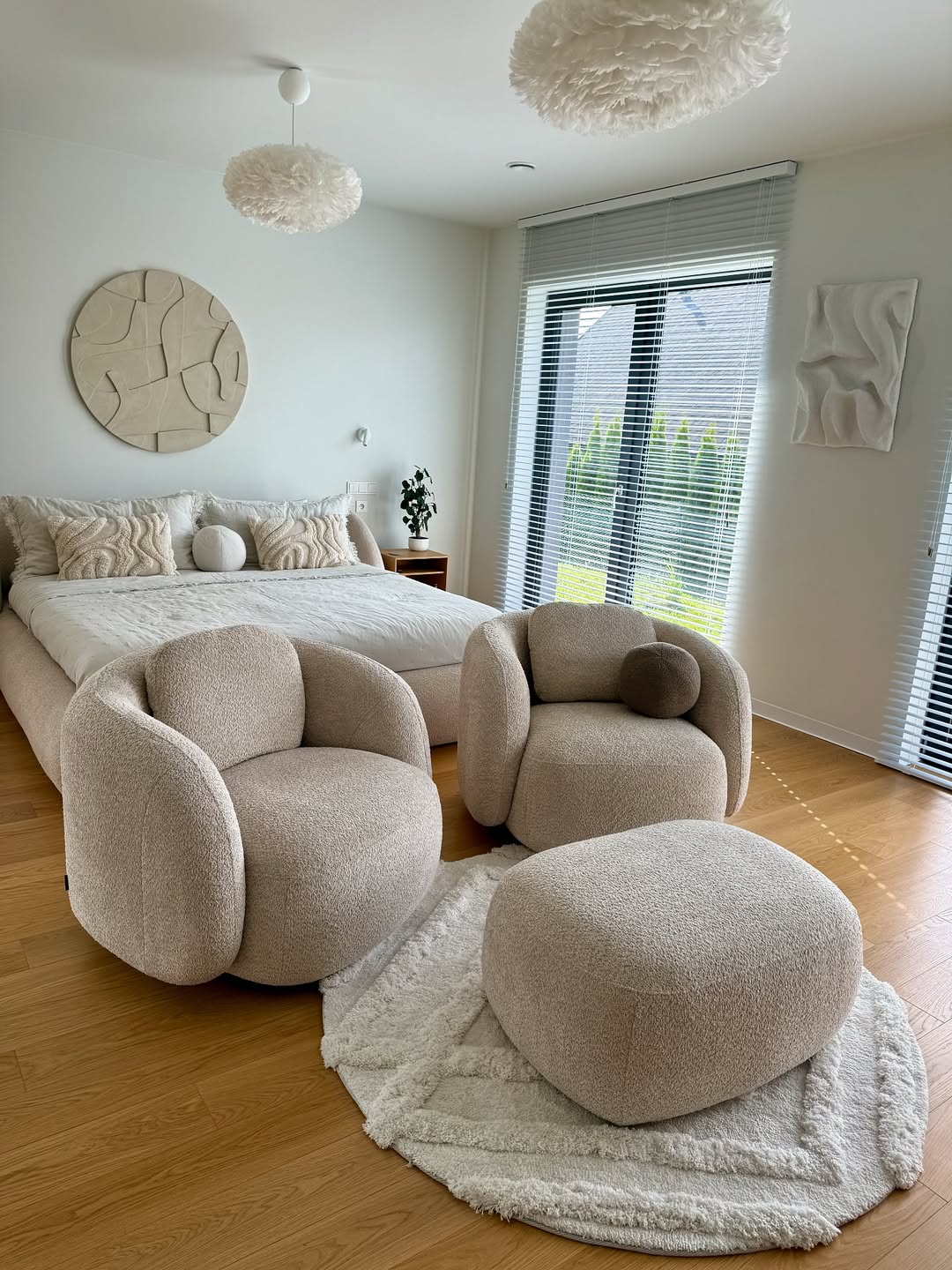
The key to a Japandi bedroom is mixing warm neutrals like creamy whites and soft beiges with muted sage green accents. These combos give you a space that’s balanced—fresh, but not cold or boring.
Get the Fail-Safe Paint Color Playbook (Free PDF)
36 proven colors • 8 ready palettes • trim & sheen guide • printable testing cards.
You’ll find real paint color names here, plus ideas on how to blend neutrals with sage green to totally transform your bedroom into a tranquil sanctuary. Whether you’re just figuring out the basics or hunting for decorating tips, this guide’s got you covered for your Japandi-inspired retreat.
What Is Japandi Bedroom Style?
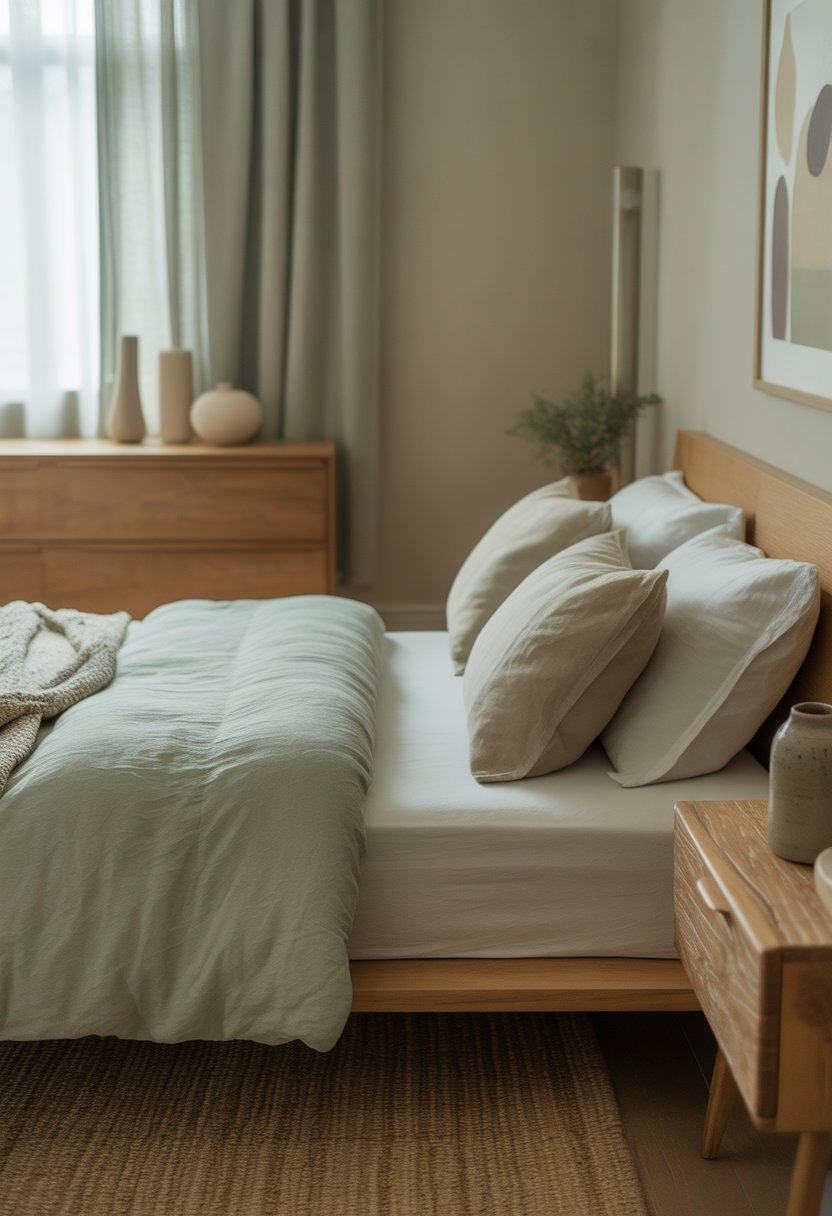
Japandi design is all about blending Japanese minimalism with Scandinavian warmth to create peaceful bedrooms. You’ll see lots of natural materials, neutral colors, and simple furniture—nothing feels crowded or cluttered here.
The Origins of Japandi Design
This style grew out of two traditions that both value simplicity. Japanese design has centuries of minimalist philosophy, focusing on empty space and natural harmony.
Scandinavian style brings in cozy warmth—think light woods, soft textures, and a definite focus on comfort. Both cultures care more about quality than quantity.
The term “Japandi” is just a mashup of “Japanese” and “Scandinavian.” The look really started to catch on in the 2010s, as more people craved calmer home spaces.
Key influences:
- Japanese wabi-sabi: beauty in imperfection
- Scandinavian hygge: cozy comfort
- Love of natural materials
- Focus on functional, beautiful things
Key Characteristics of Japandi Bedrooms
A Japandi bedroom should feel calm, uncluttered, and intentional. Instead of filling the room with stuff, you pick a few high-quality pieces you really like.
Typical Japandi bedroom elements:
- Low platform beds or even floor mattresses
- Light-toned natural wood furniture
- Neutral color palettes—whites, beiges, grays
- Soft textiles: linen, cotton, that sort of thing
- Minimal artwork or simple nature prints
Storage gets tucked away behind smooth cabinet doors. Open shelving packed with trinkets? Not here.
Lighting feels gentle—paper lanterns or simple table lamps are perfect. Overhead lighting that’s harsh or clinical just doesn’t fit the vibe.
Plants? Yes, but keep it simple. One big plant looks better than a bunch of tiny ones scattered everywhere.
Minimalism and Simplicity in Japandi Interiors
Japandi bedrooms stick to minimalist design, so everything in the room has a purpose. You keep what you need and what you love, nothing extra.
Empty space matters as much as the stuff you bring in. That open feeling helps you unwind and sleep better.
Get the Fail-Safe Paint Color Playbook (Free PDF)
36 proven colors • 8 ready palettes • trim & sheen guide • printable testing cards.
Simplicity shows up in:
- Furniture with clean lines
- Limited color schemes
- Hidden storage
- Just a few decorative objects
- Natural, sometimes even unfinished, materials
Your minimalist design shouldn’t feel cold, thanks to warm wood and soft fabrics. That’s why Japandi isn’t as severe as some other minimalist styles.
It’s all about quality, not quantity. One gorgeous wooden dresser beats a bunch of flimsy storage bins any day.
Key Principles of Japandi Color Palettes
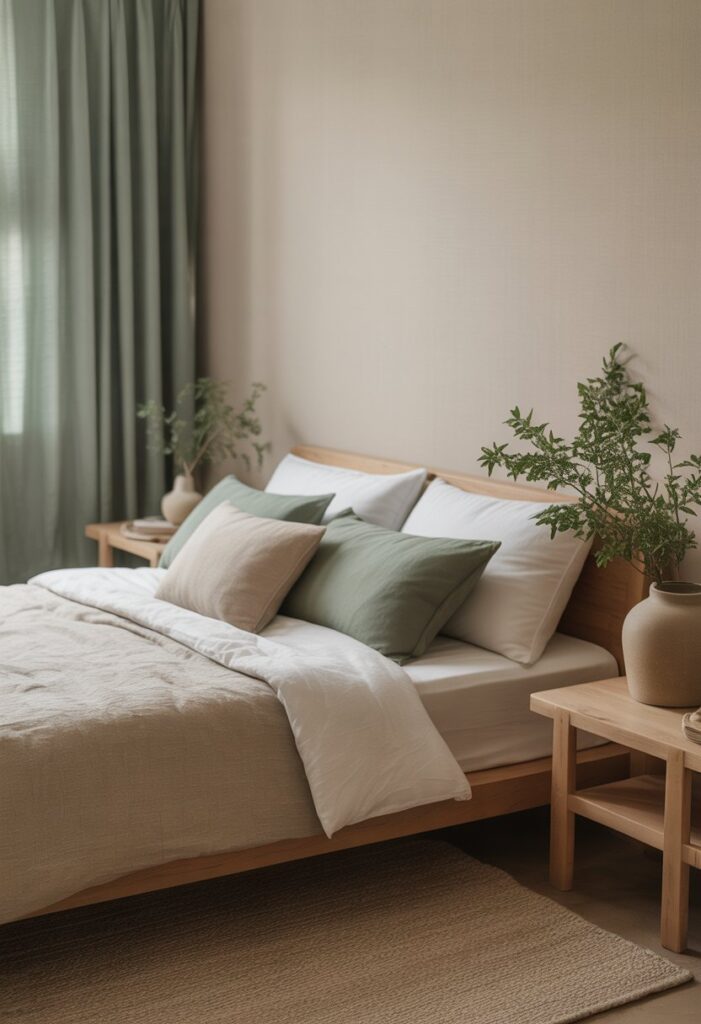
Japandi color palettes really lean on three ideas: start with neutrals, layer your tones, and keep a good mix of warm and calming shades. That’s how you end up with bedrooms that feel peaceful but still welcoming.
Role of Neutrals in Japandi Bedrooms
Neutrals are the backbone here. They give you a calm foundation so your bedroom feels like a safe, relaxing spot.
Warm whites (like Swiss Coffee or Ballet White) work better than harsh, cold whites. They’re cozy, not yellow or dingy.
Soft grays (think Gray Mist or Tranquil Gray) add depth without shouting for attention. They just quietly elevate the space.
Beige and cream (Blank Canvas, Persuasion, that kind of thing) connect you to nature and ground the room.
With these neutrals, your furniture and natural materials can actually stand out. Wood, linen, and simple decor get to shine.
Try to keep your neutral base covering about 70% of the room—walls, big furniture, bedding, that sort of thing.
Importance of Layering Tones
Layering tones keeps your bedroom from feeling flat or, honestly, a little boring. It adds interest but still fits the minimalist vibe Japandi is known for.
Get the Fail-Safe Paint Color Playbook (Free PDF)
36 proven colors • 8 ready palettes • trim & sheen guide • printable testing cards.
Start with your lightest neutral on the walls. Then work in medium tones through bedding, curtains, maybe a cozy chair.
Deeper shades can show up in small doses—a charcoal pillow, a dark wood nightstand, something like that. It keeps things interesting without chaos.
Texture matters, too. A cream linen duvet with a slightly darker wool blanket? That’s depth you can see and feel.
Stick to one color family. If you start with warm beiges, keep going with warm grays and browns, not cool blues.
Balance Between Warmth and Calm
The best Japandi colors balance warmth and calm. That’s what makes your bedroom restful but still inviting.
Warmth comes from earthy undertones—mushroom grays, creamy whites, soft taupes. They make the room feel comfortable.
Calm comes from cooler undertones and muted, not-too-bright shades. These help you wind down and actually sleep.
Sage green nails this balance. It feels alive and natural, but soft enough to help you relax.
Try out paint samples at different times of day. Morning light might make a color look cooler, and evening can warm things up. Lighting really changes everything. Warm LED bulbs can help cool colors feel cozier, while daylight tones down warmth if it feels like too much.
Get the Fail-Safe Paint Color Playbook (Free PDF)
36 proven colors • 8 ready palettes • trim & sheen guide • printable testing cards.
Best Japandi Bedroom Color Palette Combos With Sage Green
These sage green combos hit that sweet spot between Japanese minimalism and Scandinavian warmth. Each palette uses sage as a main wall color or an accent, paired with neutrals that really highlight the Japandi vibe.
Palette 1: Soft Taupe and Sage
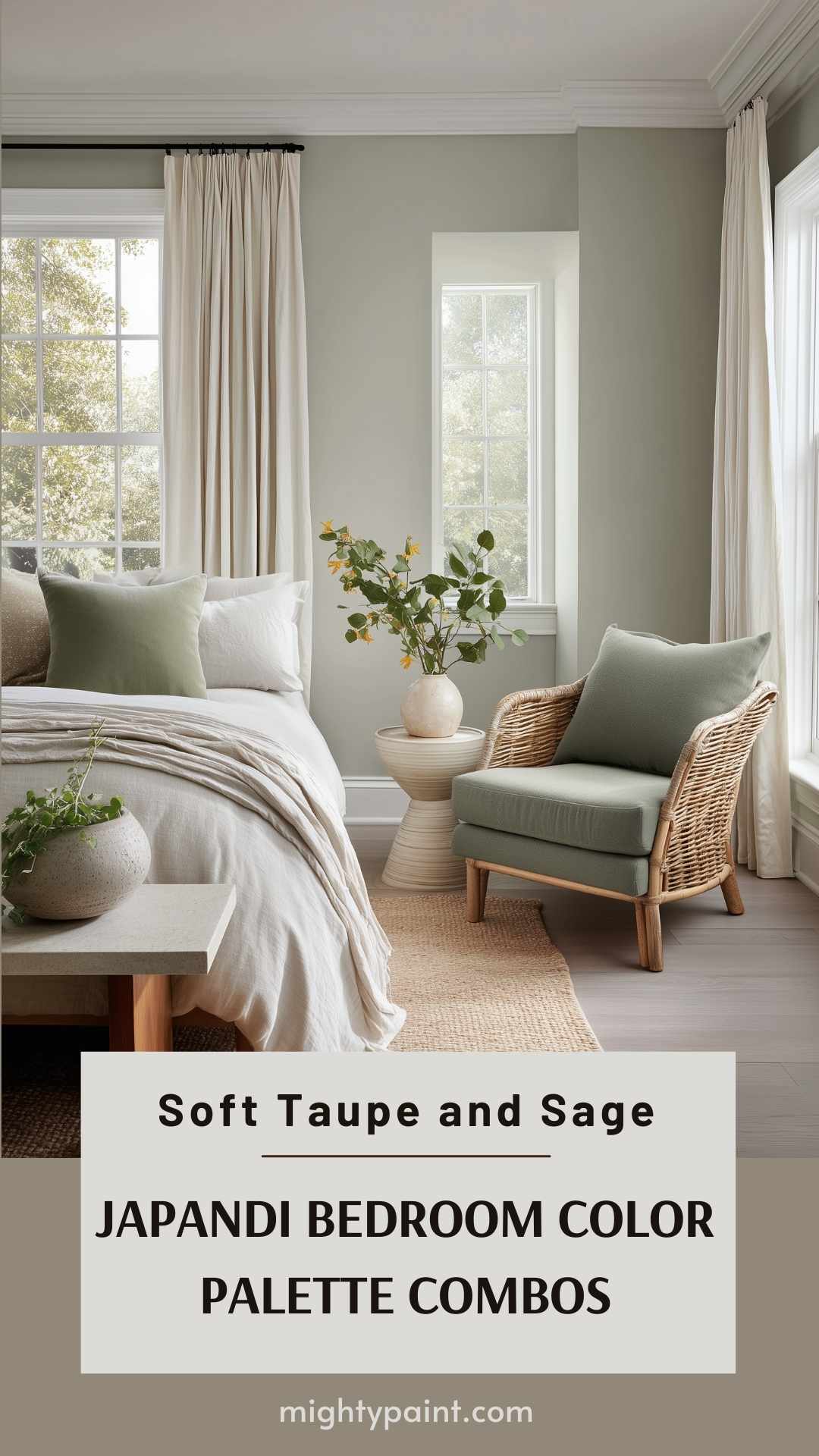
Soft taupe walls set a warm base, making sage green accents feel calm and natural. Try Benjamin Moore’s Smokey Taupe for the walls, then bring in sage with bedding or throw pillows.
Taupe grounds the space, while sage adds a hint of color that’s never too much. Sage green curtains or a reading chair are nice touches for extra interest.
This combo just works with light wood furniture and linen textures. Taupe’s warmth and sage’s coolness play off each other really well.
White trim helps both shades stand out. Add bamboo or rattan accessories for a little more Japandi flavor.
Palette 2: Warm Beige and Muted Sage

Sherwin-Williams Balanced Beige on the walls gives you a cozy backdrop for muted sage accents. That warm beige has a bit of yellow, so sage green feels even more welcoming.
Muted sage in a rug or some artwork brings the outdoors in. Beige keeps things light, while sage adds a bit of depth and calm.
This one shines in bedrooms with lots of natural light. Beige bounces the light around, and sage creates calm spots for your eyes to land.
Finish it off with cream bedding and natural wood nightstands. Woven baskets in natural fibers are a nice touch, too.
Palette 3: Greige and Dusty Sage
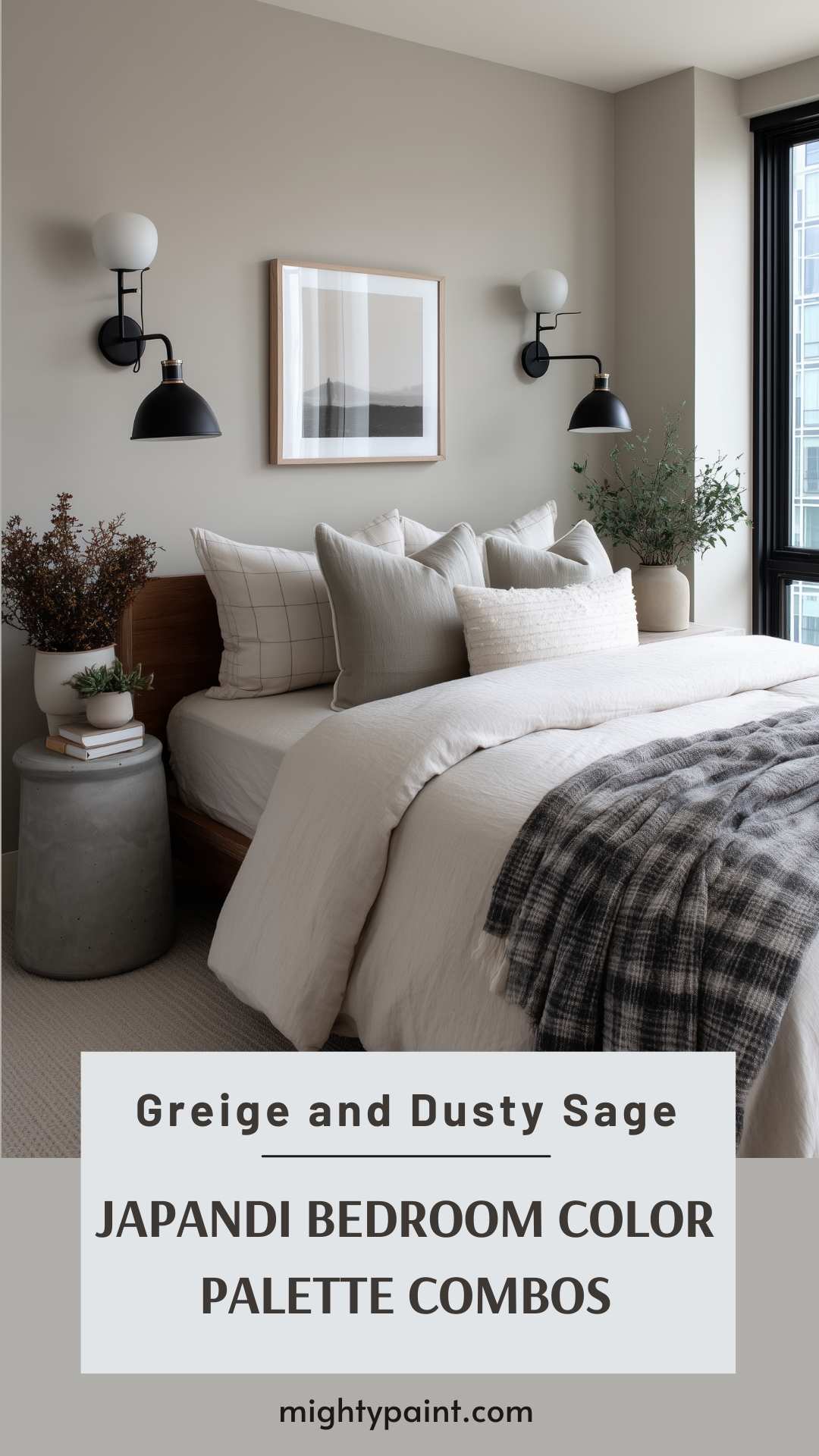
Greige walls are a perfect neutral for dusty sage accents. Benjamin Moore’s Thunder mixes gray and beige, so it pairs with sage beautifully.
Cool greige balances the warmth in dusty sage. The result? A sophisticated mix that feels modern yet timeless.
Dusty sage works well in throws or pillows—just enough color to keep things interesting. Muted shades keep the Japandi calm intact.
Try black metal accents or concrete textures with this palette. Natural wood keeps it from getting too chilly.
Palette 4: Charcoal and Sage
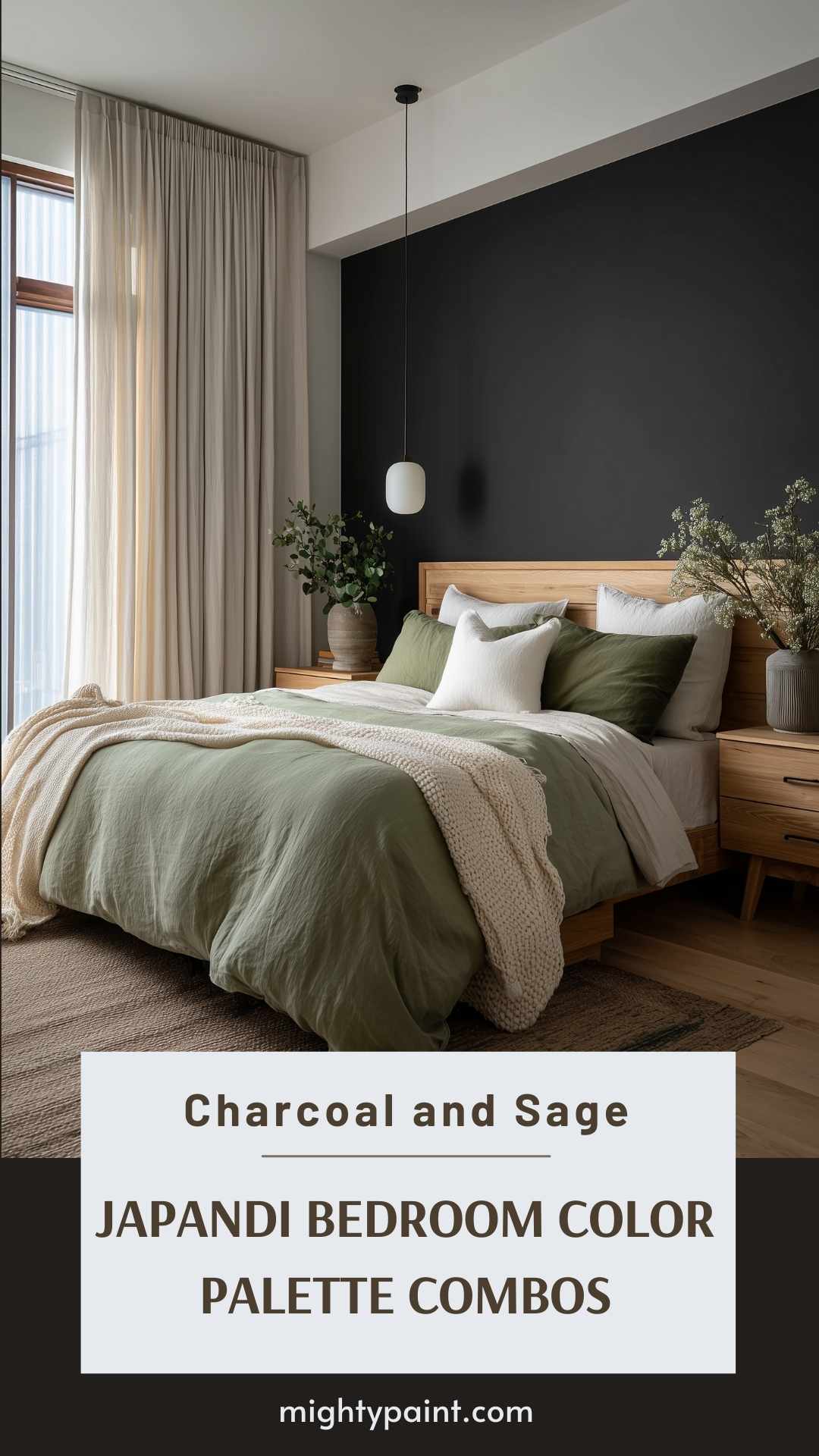
Deep charcoal gives you drama, especially when you pair it with fresh sage green. Use charcoal behind the bed as an accent wall, and keep the rest of the walls soft white or cream.
Sage green bedding or curtains really pop against charcoal. The combo stays true to Japandi roots with its natural color connection.
Contrast between dark and light adds depth. Sage bridges the gap between charcoal and lighter neutrals.
Lighten things up with natural wood furniture. Cream or white accents stop the charcoal from feeling too heavy next to the sage.
Palette 5: Creamy White With Sage Accents
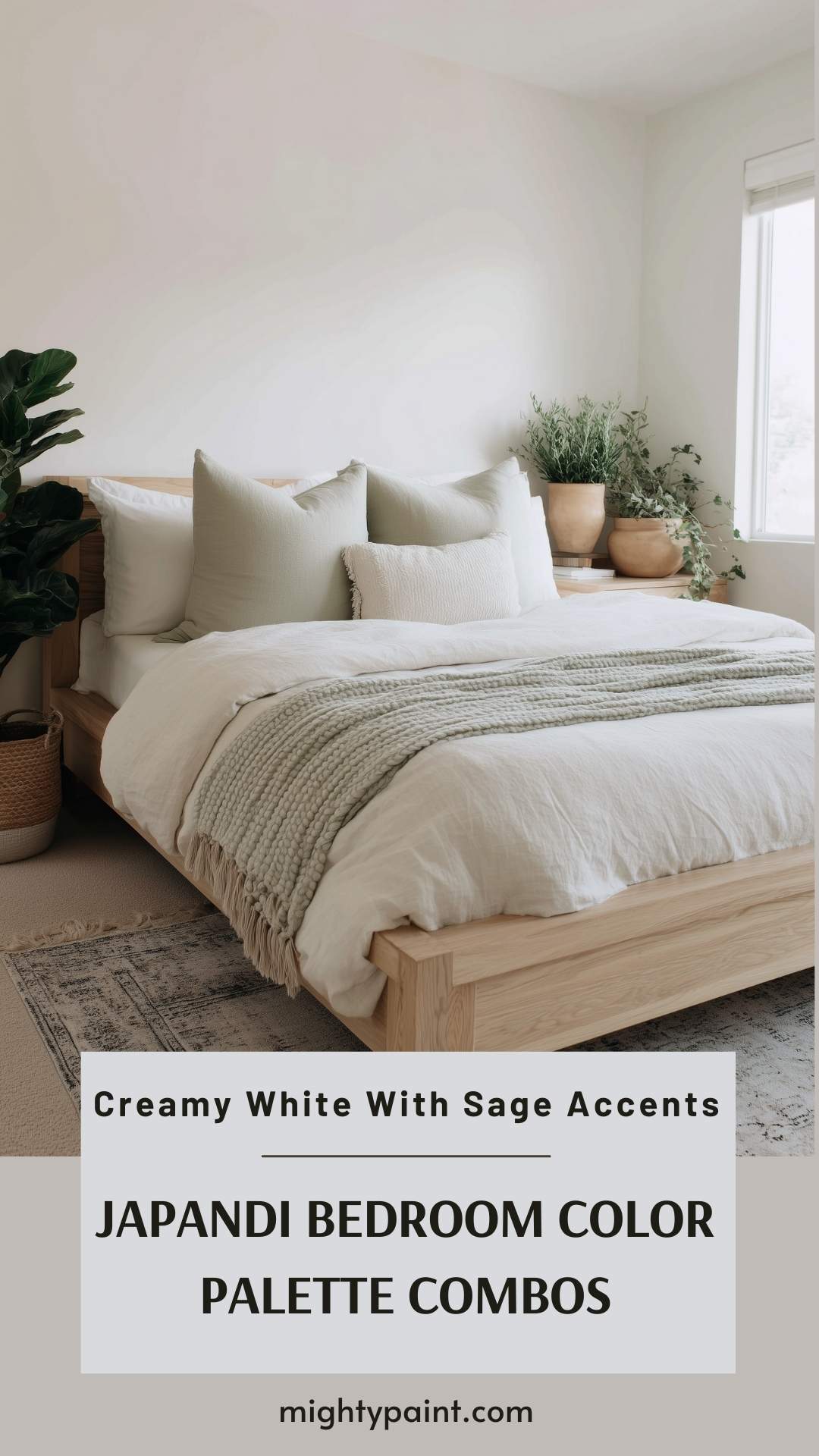
Behr’s Blank Canvas is a creamy white that makes sage green accents look fresh and natural. This combo is classic Japandi—simple, clean, and grounded in nature.
Sage works great for pillows, throws, or even a single accent wall. Creamy undertones in the white make sage feel softer than it would against a pure white.
The result is a light, peaceful bedroom that just feels restful. Natural light really brings out the best in both colors.
Pair with light wood furniture and linen bedding. Add a few plants in ceramic pots for a natural pop of living sage green.
Palette 6: Stone Grey and Sage
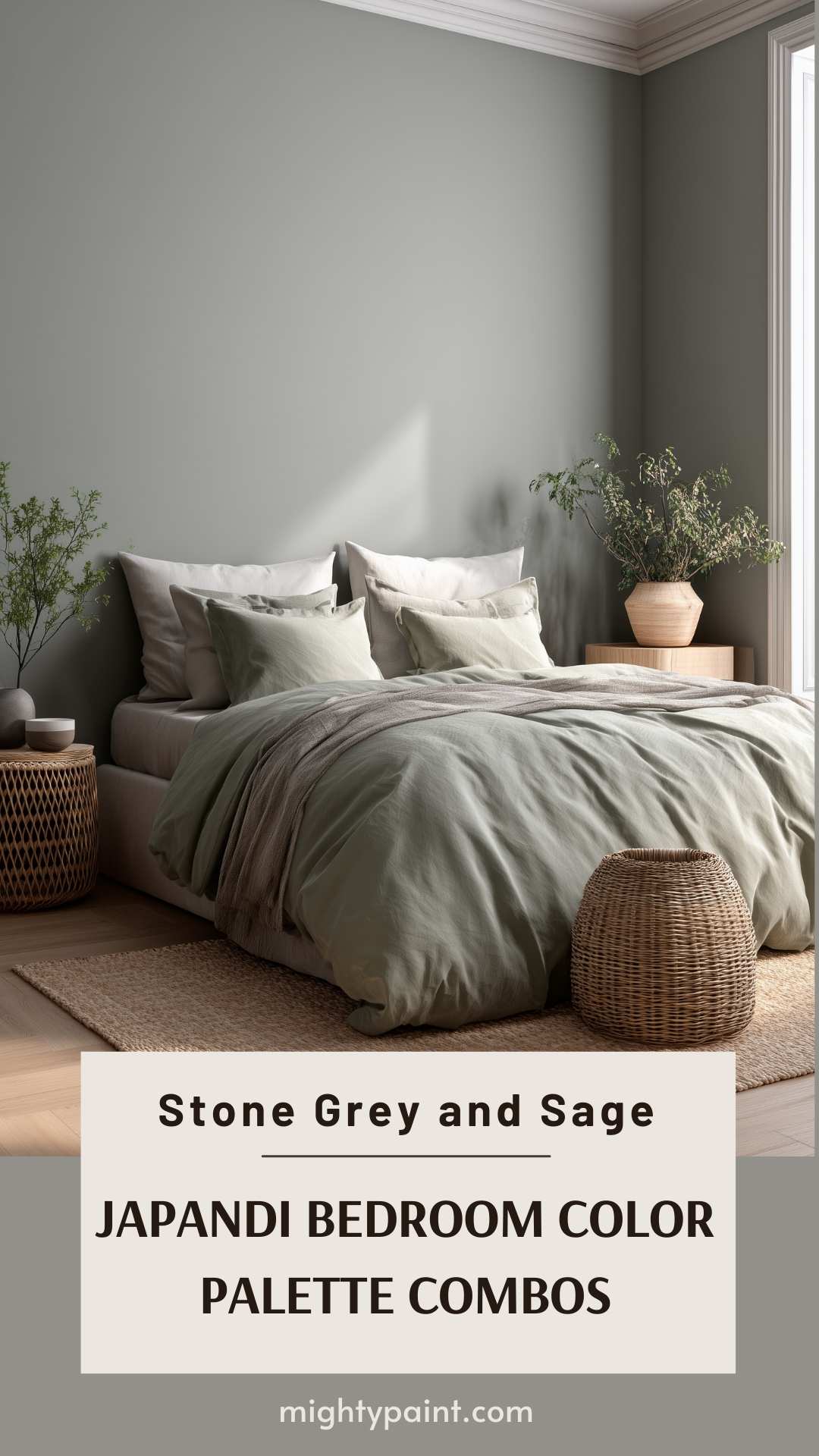
Clare’s Set in Stone is a medium gray with warm undertones—perfect for sage green accents. It doesn’t make the room feel cold, which is key for Japandi style.
Stone gray walls let sage bedding or art stand out. The overall vibe is grounded and natural, just right for a calming bedroom.
Stone and plant colors together make the space feel organic. Muted tones keep everything peaceful.
Brighten it up with white trim and light wood. Natural fiber rugs and woven textures keep the room from feeling too spare.
Palette 7: Walnut Brown and Light Sage
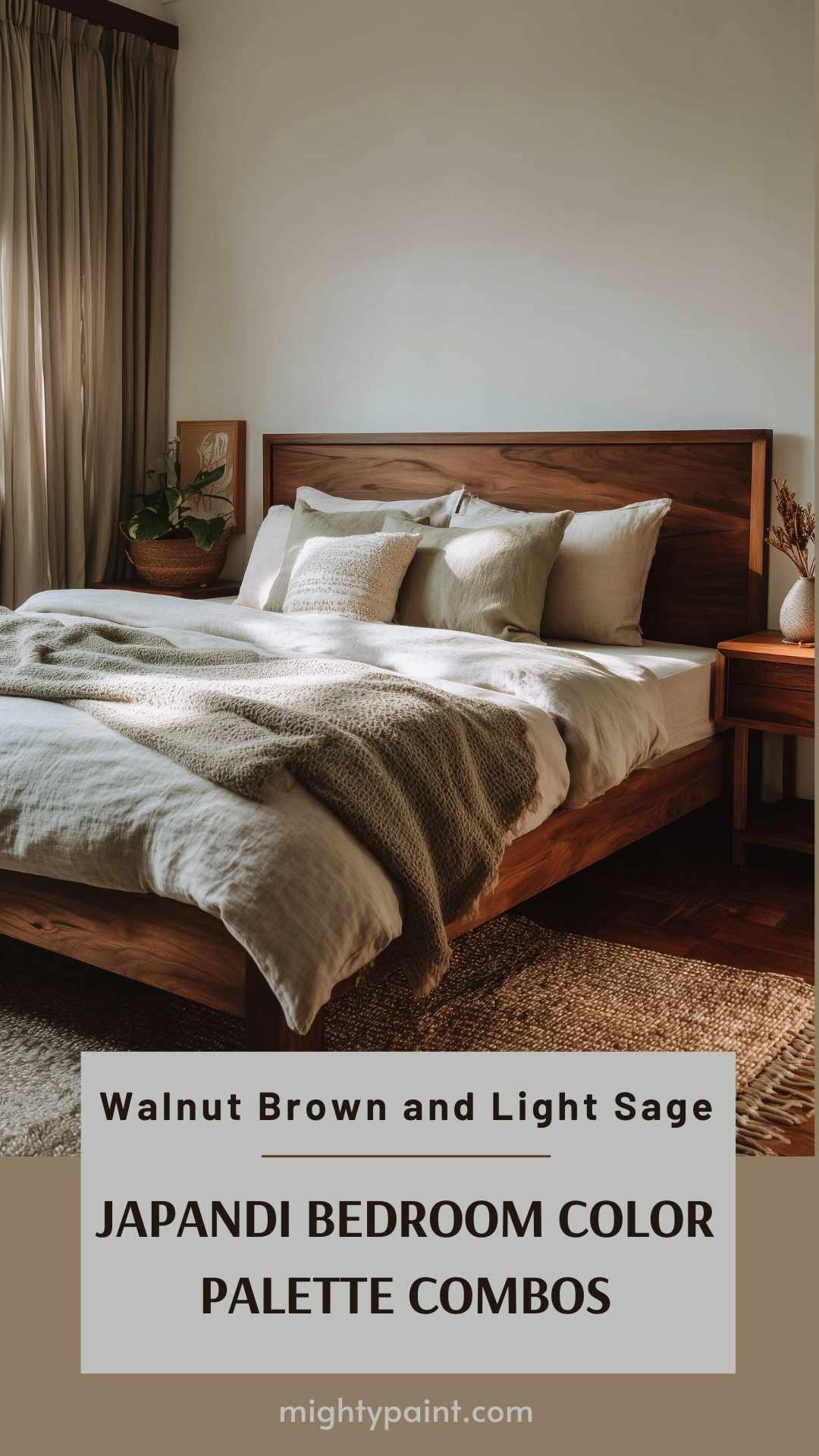
Rich walnut brown gives a cozy feel that works well with light sage green accents. Try walnut brown in your wood furniture or maybe as an accent wall.
Light sage green in your textiles softens the walnut’s richness. This mix brings a bit of the outdoors in, thanks to natural wood and those plant-inspired greens.
The warm brown and cool sage combo keeps things interesting without feeling forced. Both colors feel earthy and really fit the japandi vibe with their natural roots.
Cream or off-white walls help balance out these deeper shades. Natural textures like jute and linen just add to the earthy mood here.
Palette 8: Off-White and Sage
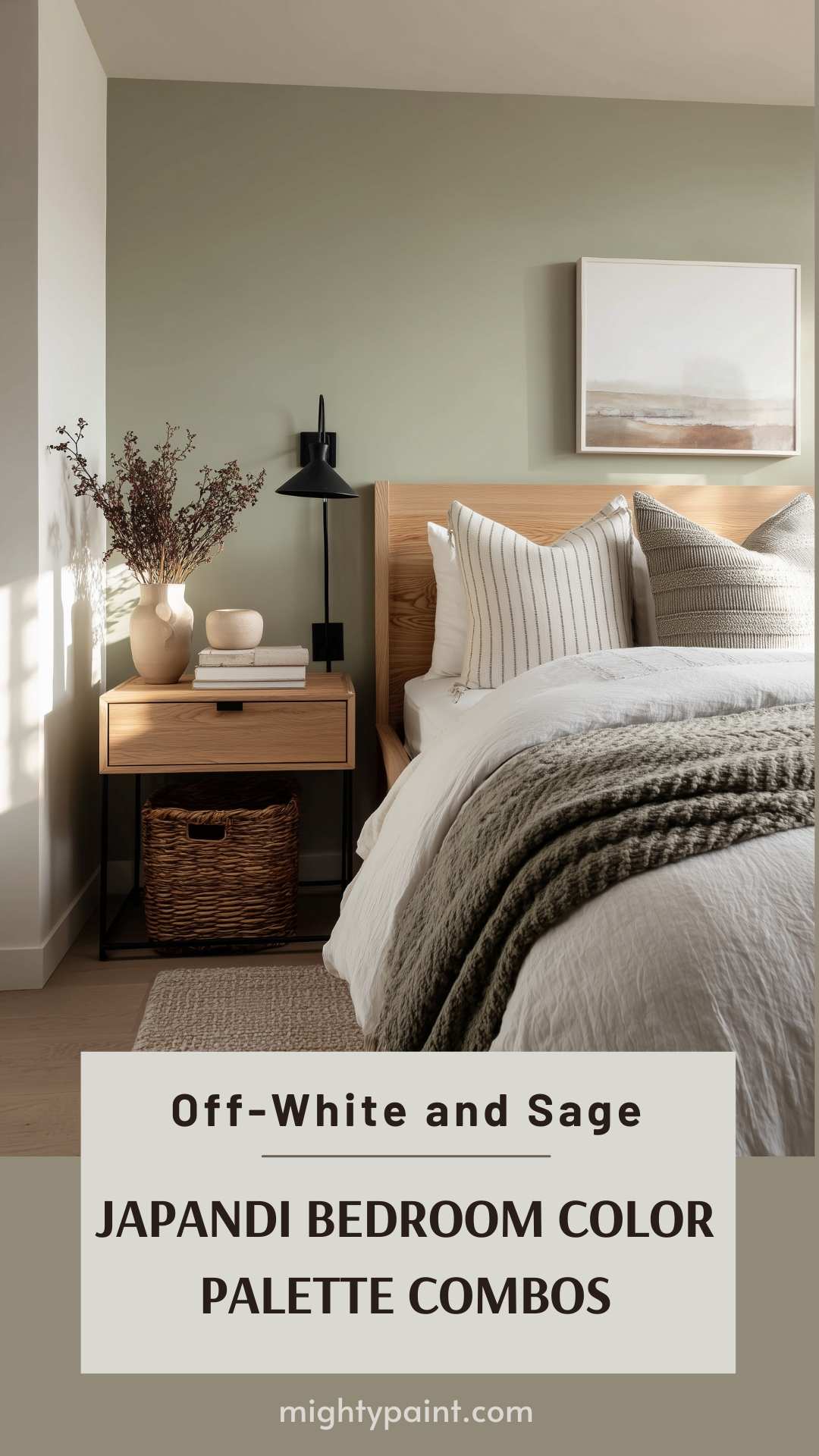
Sherwin-Williams Shoji White sets up a mellow neutral backdrop for sage green accents in your bedroom. This off-white has a hint of gray that plays nicely with sage.
Sage green works as a wall color or just for accents in this palette. You could paint one wall sage and leave the rest off-white if you’re into that.
This combo feels clean and fresh, but still warm, thanks to the off-white base. The colors help make the bedroom feel calm and restful.
Natural wood furniture and organic textures really bring out both shades. Black metal accents add a little contrast, but don’t mess with the peaceful look.
Palette 9: Mushroom and Silvery Sage
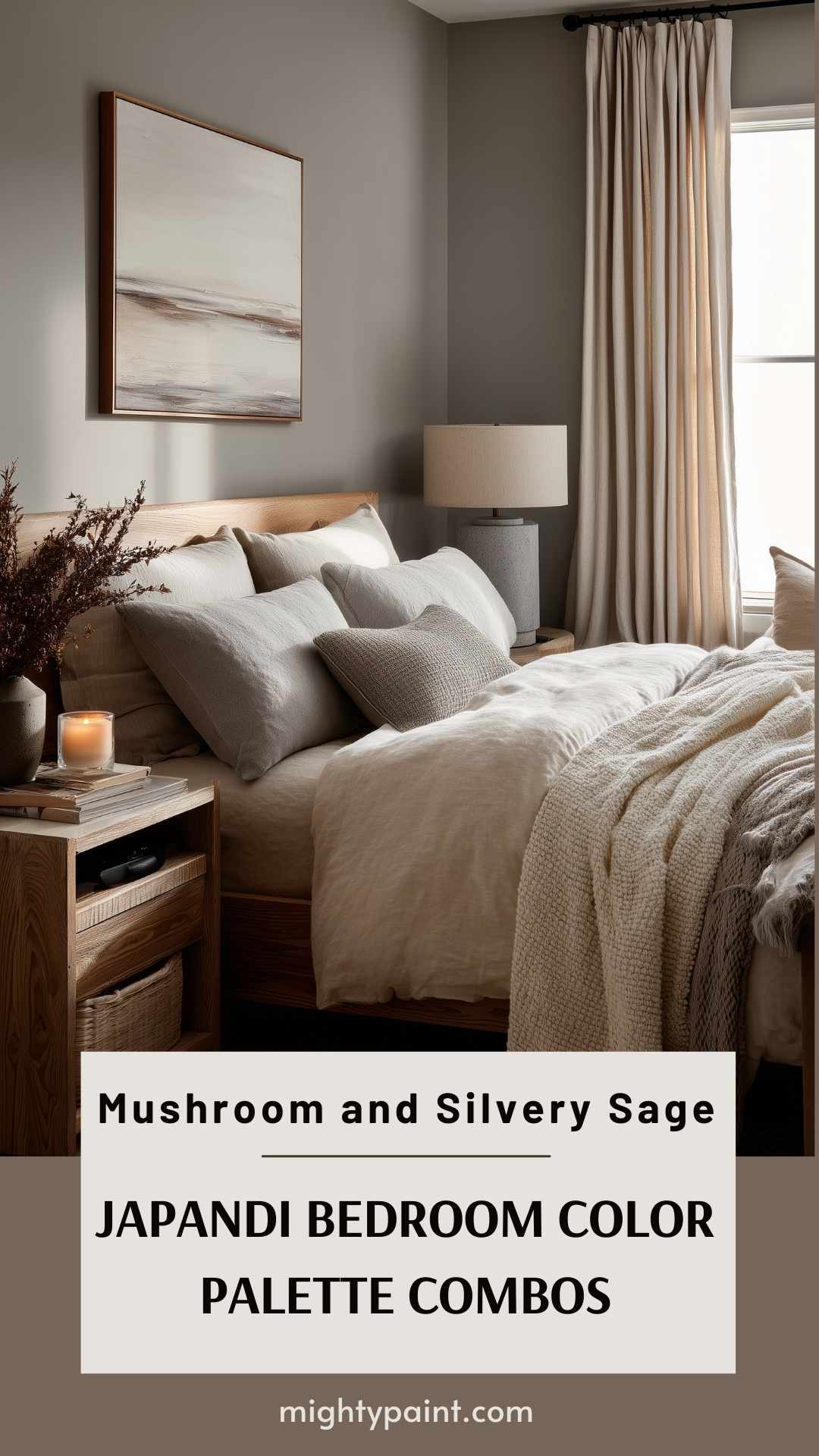
Warm mushroom gray lays down an earthy base for silvery sage accents in a japandi bedroom. The two together feel modern but still grounded.
Mushroom gray’s brown undertones warm up the silvery sage. You end up with a palette that feels balanced and relaxing.
Try silvery sage in your bedding or window treatments for a gentle pop of color. The muted tones keep that minimalist japandi feel going strong.
Natural materials like wood and stone work well with these colors. Cream accents can brighten things up without losing the sophisticated vibe.
Palette 10: Pale Sand and Deep Sage
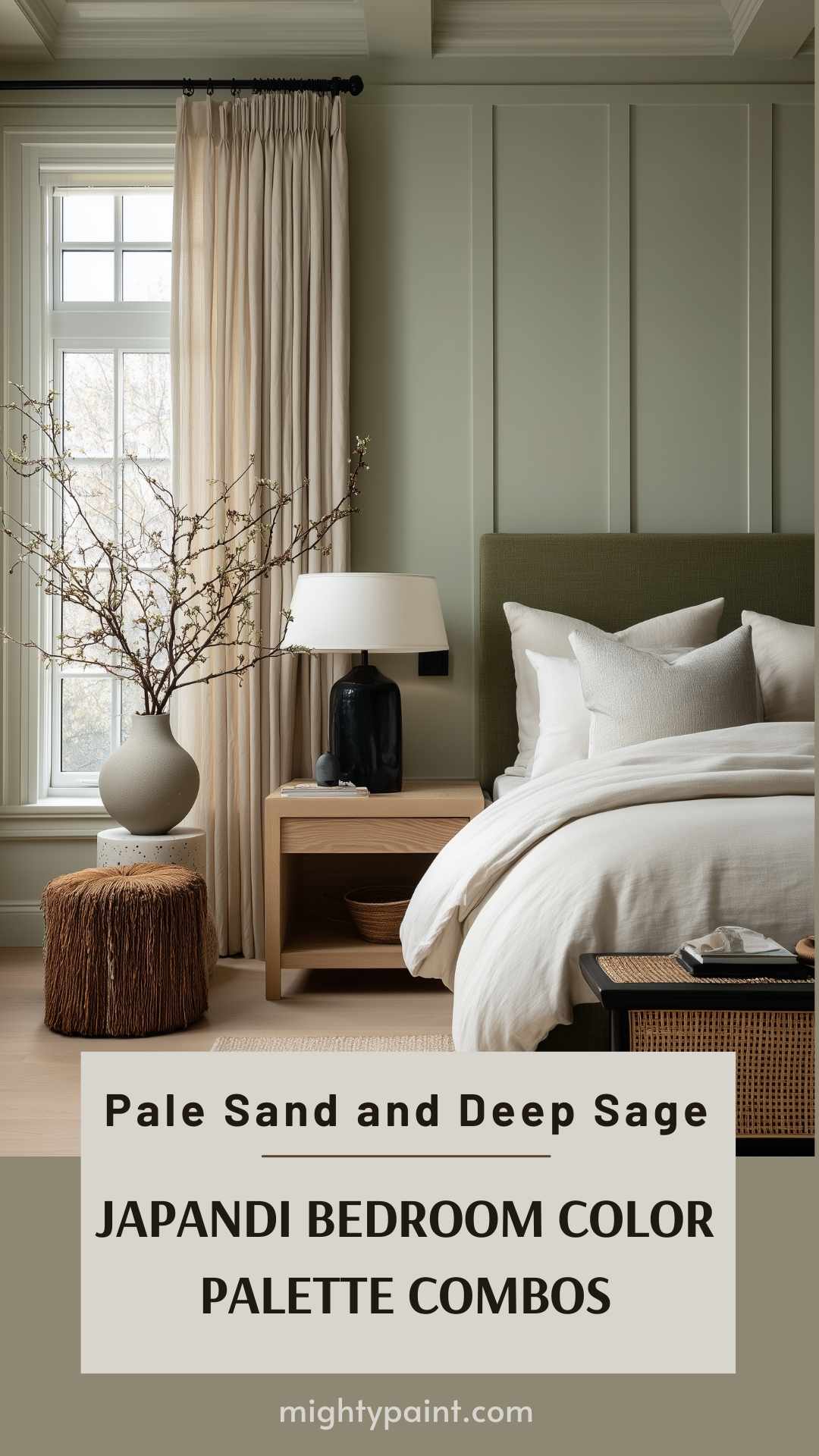
Farrow & Ball’s Slipper Satin provides a pale sand base that makes deep sage accents feel rich and grounding. This combination brings desert and forest elements together naturally.
Keep walls and ceiling in Slipper Satin for soft, diffused light. Layer deep sage on the upholstered headboard, curtains, or a single built-in cabinet. In smaller rooms, confine sage to textiles for depth without visual weight.
The warmth of pale sand prevents sage from reading cold. Add slim black or dark bronze lines—picture frames, curtain rods, or sconces—for quiet contrast that suits the Japandi look. Crisp off-white bedding keeps the palette airy.
Finish with natural textures: limed oak or ash, rattan, linen, and a wool throw for tactile calm. Stone or travertine on a side table adds earthy gravitas. A single branch in a ceramic vase (olive or eucalyptus) echoes the green without clutter.
Popular Japandi Neutral and Sage Paint Names
The right paint colors can totally change the vibe of your Japandi bedroom. These carefully picked neutrals and sage greens work together to bring calm and a bit of that natural warmth into your space.
Best Neutral Paint Colors for Japandi Bedrooms
Benjamin Moore Dove White gives you a soft backdrop with gentle gray undertones. It looks great with natural wood furniture and warm textures.
Sherwin-Williams Balanced Beige adds warmth without shouting for attention. Pair it with white bedding for a bedroom that feels cozy and inviting.
Benjamin Moore Thunder is a greige that mixes gray and beige. It’s a solid pick for an accent wall behind your bed.
Clare Flatiron lands in the medium taupe zone—modern, but not cold or trendy. It adds depth without straying from the Japandi palette.
Farrow & Ball Slipper Satin brings sandy beige tones that feel easy and natural. Rooms painted with it just seem bigger and brighter somehow.
Behr Blank Canvas offers a warm creamy white—never harsh or cold. It’s a winner in bedrooms with lots of sunlight.
Best Sage Green Paints for a Natural Look
Sherwin-Williams Softened Green nails the perfect sage for Japandi rooms. This muted green brings a bit of nature in without taking over the space.
Benjamin Moore October Mist gives you a subtle green-gray that shifts with the light. It sets a calm, peaceful mood in bedrooms.
Clare Current Mood is a sophisticated sage that works as an accent wall or all over. It pairs up beautifully with warm wood tones.
Farrow & Ball Vert de Terre brings a muted, earthy sage that feels grounded and totally Japandi.
Pair these sage greens with warm neutrals and natural materials like bamboo or oak for the best effect.
How to Use Japandi Color Palettes in Your Bedroom

Getting the colors right is a big part of making your bedroom feel calm and Japandi. You want to balance main colors with supporting tones, and add texture with different finishes.
Applying the 60-30-10 Rule in Japandi Style
The 60-30-10 rule fits Japandi bedrooms perfectly. Put your main color—about 60%—on the walls and big pieces of furniture.
Main colors should be soft neutrals like creamy white or warm beige. Try Benjamin Moore’s Simply White or Sherwin Williams’ Alabaster for the walls.
Use your secondary color for about 30% of the room—think muted gray or sage green on bedding, curtains, or maybe an upholstered headboard.
Get the Fail-Safe Paint Color Playbook (Free PDF)
36 proven colors • 8 ready palettes • trim & sheen guide • printable testing cards.
Shades like Benjamin Moore’s Edgecomb Gray work well here. They add some depth but don’t overpower.
The last 10% is for accent colors—charcoal gray or earthy clay on pillows, art, or small decor. Just a few pops to keep things interesting.
Choosing Your Main, Secondary, and Accent Colors
Start off with a main color from the warm neutral family. Creamy whites, soft beiges, or light taupes are usually best for bedroom walls.
Your secondary color should work with, not against, the main one. Muted sage green, soft gray, or a blush sand gives you the right contrast.
Check how these colors look together in different lighting. Sunlight really changes how warm or cool they seem.
Accent colors give the room personality. Deep charcoal, moss green, or a golden straw can be just enough in small touches.
Stick with muted, natural shades. Bright or saturated colors can mess with the calm Japandi vibe.
Pick colors that make you feel at ease when you see them together. That’s what really matters.
Layering Finishes for Depth and Warmth
Layering tones with different finishes keeps your bedroom from feeling flat. Try matte wall paint and semi-gloss trim for a bit of contrast.
Go for natural finishes on wood furniture and floors. Raw wood, linen, and stone textures add warmth without needing more color.
Play with paint sheens, too. Flat paint on the walls feels soft, while eggshell on furniture is more durable.
Add texture with materials—woven baskets, bamboo blinds, cotton bedding. It all helps break up the look.
Use a few shades from the same color family. Three tones of beige or gray can make the space feel richer and more layered.
Natural materials like jute rugs and wooden nightstands bring warmth to cool gray walls, and it just works.
Tips for Testing Paint Colors in Bedroom Lighting
Paint big samples right on your bedroom walls—tiny swatches just don’t cut it. Colors can shift a lot when you see them on a larger area.
If you’ve got both north- and south-facing windows, try your samples in both spots. North light feels cooler, kind of blueish, while south light brings out the warmth.
Check your samples throughout the day. Morning, late afternoon, even under your bedside lamp—each time brings a different vibe to the color.
Go for samples that are at least 2×2 feet. Those little paint chips from the store? They barely show you anything real.
Keep the samples up for a few days. Let yourself adjust and notice how the colors work with your routine—sometimes a color grows on you, or not.
Get the Fail-Safe Paint Color Playbook (Free PDF)
36 proven colors • 8 ready palettes • trim & sheen guide • printable testing cards.
Stick your samples near your furniture and fabrics. Bedding, curtains, all that stuff—it really changes how the wall color comes across.
Bringing Japandi Style Together: Decor and Finishing Touches
Natural Materials and Textures
Lean hard into tactile, honest materials. Think linen duvet + wool throw, a jute or sisal rug, and light oak or ash nightstands. Rattan or cane adds airiness; stone (travertine, soapstone) grounds the palette.
Keep finishes matte or oiled—no high gloss. A limewash or soft-matte wall adds depth without color noise. Layer 2–3 textures per zone (bed, window, floor) so the room feels warm yet uncluttered.
Minimalist Patterns and Accessories
Patterns should whisper: slim pinstripes, micro–windowpane checks, subtle slub weaves, or sashiko-inspired stitches. One patterned piece per surface is plenty.
Accessories: a paper lantern, a single ceramic vase, a small stack of books, and an understated tray on the nightstand. Choose black or dark-bronze lines for frames/lamps to add quiet contrast.
Plants and Green Accents for Tranquility
Go for fewer, larger plants over many small ones: olive tree, rubber plant, ZZ plant, or a parlor palm. Pot them in unglazed stoneware, terracotta, or sand-toned matte pots.
Echo your sage accents sparingly—throw pillow, lumbar cushion, or a light bedcover—so the greens feel intentional, not theme-y.
Frequently Asked Questions
What are the popular neutral color combinations for a Japandi-style bedroom?
- Creamy white + warm beige (e.g., Behr Blank Canvas + Sherwin-Williams Balanced Beige).
- Greige + soft white (Benjamin Moore Edgecomb Gray + Simply White).
- Mushroom taupe + off-white (Clare Flatiron + Behr Swiss Coffee).
These combos keep the space calm, with enough warmth to avoid sterility.
Can you suggest some harmonious sage color mixes for a Japandi-themed room?
- Sage + pale sand (Farrow & Ball Slipper Satin + SW Softened Green).
- Dusty sage + greige (Benjamin Moore October Mist + BM Thunder).
- Silvery sage + mushroom (Farrow & Ball Vert de Terre + a mushroom taupe like Clare Flatiron).
Use sage on textiles or one accent wall; keep trims creamy, not stark.
What are the trending paint names for achieving a Japandi-inspired neutral bedroom palette?
- Warm whites/creams: Behr Blank Canvas, SW Alabaster, BM Simply White, F&B School House White.
- Greiges/taupes: BM Edgecomb Gray, BM Thunder, Clare Flatiron, SW Accessible Beige.
- Soft beiges/sands: F&B Slipper Satin, Behr Swiss Coffee.
All pair well with light woods and matte black details.
How to select wood tones that complement a Japandi bedroom color scheme?
Choose lighter species (white oak, ash, birch) for the primary furniture; reserve walnut for a single accent (headboard or dresser).
Match undertones: warm walls → honey/oat woods; cooler greige walls → neutral oak or ash. Keep finishes natural (oil, wax, low-sheen lacquer) and avoid orange/red stains.
Which Behr paint colors align with the Scandinavian elements of the Japandi aesthetic?
- Walls: Blank Canvas (creamy white), Swiss Coffee (soft warm white), Wheat Bread (gentle greige).
- Accent sage/green: Jojoba, Sage Gray, Nature’s Gift (muted, nature-forward).
Use eggshell on walls and semi-gloss on trim for subtle sheen contrast.
What wall colors would best suit a kitchen designed in the Japandi style?
- Warm light neutrals: Behr Blank Canvas, SW Alabaster, BM Swiss Coffee—keep cabinetry light oak/ash.
- Greige for depth: BM Edgecomb Gray or SW Accessible Beige with creamy trim.
- Soft sage accents: BM October Mist or SW Softened Green on an island or pantry door.
Stick to matte/eggshell walls, satin for high-use zones, and keep hardware simple in black or brushed brass.
